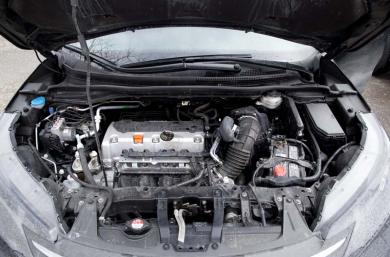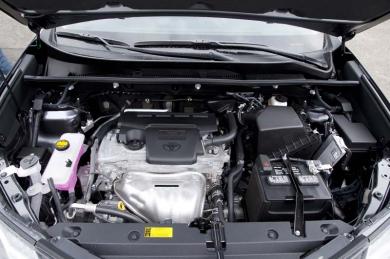Powertrain
Now that both the RAV4 and CR-V are on an even footing offering exclusively inline-fours, we knew this powertrain category was going to be one of the most closely contested. Could the CR-V’s 2.4L 185 hp edge out the RAV4’s 2.5L I4 making 176 hp? The RAV4 answers back with 172 lb-ft of torque and a six-speed automatic transmission with manual and sport modes to the CR-V’s 163 lb-ft and five-speed automatic.
In the brute strength department, there is little question that the RAV4 feels stronger, and making its peak torque and horsepower at lower engine speeds means it has more guts just dawdling around, and its 1,560 kg in XLE FWD trim is virtually equal to the AWD CR-V (1,554 kg). However, that is about where the advantage ends.
  2013 Honda CR-V LX AWD & 2013 Toyota RAV4 XLE FWD. Click image to enlarge |
Both buzz irritatingly when you wind them up, both lack meaningful power, and anyone looking for such power will need to step up to a competitor with a turbo-four or V6, or be prepared to be patient when accelerating. I would classify this level of power saddled with this weight as enough, just barely. Once up to speed, of course, they are entirely adequate for moving the cars along briskly, even at GTA 400-series highway speeds.
However, we were well out of the city on 60-, 70-, and 80-limit roads, and when driving varied terrain at speeds between 60 and 110 km/h, the RAV4 was consistently confused about gear would best serve. Gradual inclines at 70 resulted in double downshifts, and yet firm prods of the pedal for passing were slow to provoke a gear change. As much as having six speeds seems a good idea on paper, the Honda five-speed was the better, smoother transmission, unless you are the rare individual that actually uses the manual mode (shifter controlled) when cruising around.
Overall, the CR-V just felt subtly better and more natural driving down the road, the engine a little more subdued and refined, the engine, transmission, suspension and all-wheel traction working together in mechanical harmony, or perhaps simply resonating with both of us.
Fuel Efficiency
But before we conclude this comparison, we must report on fuel consumption. According to the Natural Resources Canada testing method, the Toyota RAV4 FWD is capable of 8.7 L/100 km in the city, 6.4 on the highway and 7.7 combined; factor in AWD, and it climbs to 9.1/6.8/8.0. The US EPA method suggests 9.8/7.6/9.0 for FWD and 10.7/8.1/9.4 for AWD.
|
2013 Honda CR-V LX AWD & 2013 Toyota RAV4 XLE FWD. Click image to enlarge |
The Honda CR-V, on the Canadian cycle, in LX AWD trim as equipped, is estimated at 9.2/6.6/8.0, while a more efficient FWD drivetrain would earn 9.0/6.4/7.8. US estimates peg it at 10.2/7.6/9.0 for FWD and 10.7/7.8/9.4.
These are all close enough that they will amount to a hill of beans compared to how you drive your car. Driving these two cars on the same route, at essentially the same pace and swapping drivers periodically gave us readings of 9.1 L/100 km for the FWD, six-speed automatic RAV4, while the five-speed AWD CR-V narrowly beat it, coming in at 8.9 L/100 km.
After keeping both cars for the remainder of the week and following similar use, the gap remained with the RAV4 finishing at 9.5 and the CR-V at 9.3 (as it did over the course of an entire long-term test). On paper, this is a win for the Honda, though in reality, you wouldn’t be saving enough to buy a latte at every fill-up, and both use regular gas, so no penalties there.
But don’t trust us; a quick check of Fuelly shows that 2013 CR-V owners are managing an average of 8.9, while RAV4 users are averaging 9.4 (though this is a decidedly smaller sample group).














